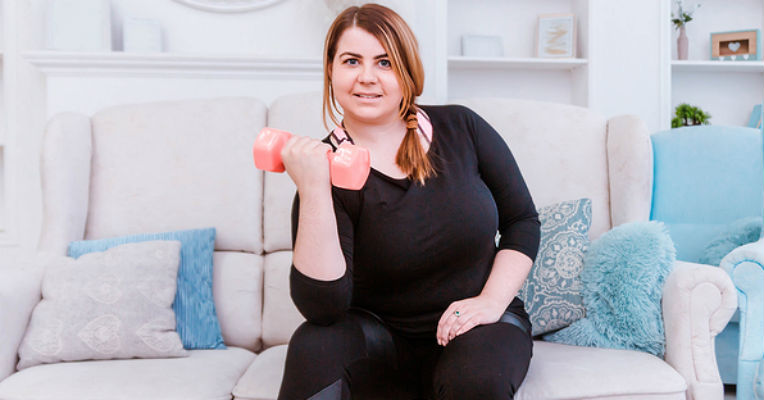You know that making better food choices and getting to the gym more often will help you reach your goals, but you cannot seem to do it. You’ve tried, but time and again, resort back to old familiar ways. What is going on here and is there any hope to change?

Download On Track with Barix: It’s Time to Conquer Destructive Habits
You’re not alone–we all settle into patterns of learned behavior, or habits, which become comfortable. This allows the brain to complete routine tasks on autopilot–freeing up mental capacity for thoughts, decisions, creativity, and actions. Habits, good or bad, tend to stay stable over time until there’s a motivation to change.
If you decide that a particular behavior or set of behaviors doesn’t serve your best interests, you can change it. Keep in mind that it usually takes repeated efforts to break out of autopilot and replace the habit with a new, healthier automatic behavior.
What’s the purpose?
Behaviors become routine for a reason—they serve a purpose. If you’ve identified a problem behavior, say eating ice cream in the evening, think about the underlying cause or purpose of the behavior. In this case, ice cream may be a reward or a comfort; it may soothe your stomach or give you a quick boost of energy. Knowing the why can help you find a healthier behavior that still addresses your need. If you’re craving ice cream because you’re tired and are looking for a quick energy boost, an earlier bedtime may be a good replacement behavior, but that won’t do the trick if it is a reward you need.
Find a better way
Rather than trying to simply stop a behavior, which leaves you with an unmet need, replace it. Armed with an understanding of why the behavior you’d like to change has become a habit; consider other behaviors that will fulfill the purpose in a more positive way. If you eat to wind down after a long day, instead, sip on a cup of green tea or no-added-sugar cider. If you snack out of boredom, instead, find something interesting and active to do during that time. If you’re a stress eater, instead, learn new deep breathing exercises to calm down.
Alter the behavior chain
A behavior chain is a series of events that lead to a specific behavior. By understanding the behavior chain, you can make alterations that lead to a different outcome.
Trigger. The behavior chain starts with an emotional, mental, social, or biological trigger. Examples of triggers include being tired, feeling stressed, seeing a particular food, driving by a favorite restaurant, going out with friend, a birthday celebration or watching a TV commercial.
Thoughts. Triggers lead to thoughts. Thoughts may justify a poor choice, “It’s my birthday so I’m going to eat everything I want.” Thoughts can also empower healthy choices, “I’m going to celebrate my birthday with a slice of sugar-free cheesecake this year—let me find a good recipe.”
Behaviors. Triggers and thoughts lead to actions or behaviors. Repeated actions become automated habits and don’t require an active decision. That means that you don’t think about many behaviors and are probably not consciously aware of the triggers or thoughts leading up to it. This is where stepping back and looking for the trigger, the purpose, and the thoughts surrounding the situation can help.
Consequences. Behaviors have natural consequences. Some of them are immediate and others not apparent for many years. Immediate consequences are more likely to help you with behavior change. For example, the immediate consequence of eating a bowl of ice cream and feeling sick would help in choosing a different action the next time there was a trigger. In comparison, a diet full of added sugar and highly processed foods typically does not produce an immediate negative reaction and the health consequences cannot be seen often for years.
Thankfully, for situations in which the natural consequence is long-term, we can create our own positive consequences to help with behavior change. Do this by creating an immediate reward for choosing the new behavior that you’re working on. This could be a dollar in a jar each time you walk on the treadmill and a penny for each squat to be used towards a new outfit you’ve been wanting.
Stay focused
It takes repetition to rewire the automatic pathways in the brain. You’ll need to be diligent and focused to practice the new behavior until it becomes routine and automatic. Log your progress to help you maintain focus for at least the first 30 days.
Don’t expect a smooth ride
You will have the tendency to go back to the original behavior, that’s normal. Changing the automated wiring in your brain is not easy, but the more you persist, the easier it will become. Be as consistent as possible, but don’t expect perfection.
Set up your environment for success
Set up the environment around you to tilt the odds of make the new behavior stick in your favor. For example, if the behavior you’re trying to change is to go to bed earlier instead of eating a bowl of ice cream; keep ice cream out of the house. Also set up a bedtime routine, turn off electronics, and cut back on evening activities. Think through the obstacles you’ll face and prepare ahead of time.
Learn from failures
You may find that despite your best efforts, you’re not changing the behavior that you want. Perhaps you didn’t correctly identify the behavior’s purpose. Maybe you weren’t eating ice cream because you were tired, but because work was making you feel so stressed. A better replacement behavior may be meditation, going for a walk, talking with a friend, or taking a hot bath. View a lack of behavior change not as failure, but as a learning opportunity that takes you one step closer to where you want to be.
Bottom line
We all have behaviors that no longer serve our life goals. Changing those behaviors is possible, but will initially take significant effort. As time goes on, those behaviors will become more automatic and we will no longer need to put forth the same level of effort.
First, you’ll need to discover why you’re doing what you’re doing—what purpose is the behavior fulfilling? Next find replacement behavior and set up the environment in your favor—make it easier for you to choose the replacement behavior. Look for triggers and be very aware of your thoughts around the behavior—you can change your thoughts to be more supportive and empowering. Finally set up a reward system to help firmly establish the new behavior. Practice the new behavior over and over. If you mess up, good—go back to the drawing board and come up with an even better plan.
Step by step you can form better habits that support becoming the person you want to be.
Recipes
Balsamic Glazed Pork Chops
4 center cut boneless pork chops, pounded to 3/4 inch thick
½ tsp salt
½ tsp ground black pepper
1 tsp garlic powder
2 T olive oil
2/3 c balsamic vinegar
2 tsp. Splenda®
Trim fat from pork chops and pound each chop to 3/4 inch thickness. Season chops on both sides with salt, pepper, and garlic.
Heat pan 1 minute, add olive oil, heat one minute more, then add pork chops and cook over medium high heat until well browned on both sides and cooked through, about 5 minutes total. Place pork chops on a plate. Lower pan heat slightly; add vinegar and Splenda; cook until slightly thickened–about 2 minutes.
Put pork chops back into pan with any liquid which has collected on plate, and cook about 4 minutes, turning several times to glaze pork chops with sauce. Serve hot. Pour remaining sauce over pork chops. Makes 4 servings.
Nutrition information per serving: 302 calories, 29 grams protein, 17 grams fat, 2 grams carbohydrate, 315 mg sodium.
Black Bean Chili
1 Tbsp. olive oil
1 onion, chopped
2 red bell peppers, seeded and chopped
1 jalapeno pepper, seeded and minced
10 fresh mushrooms, sliced
6 roma tomatoes, diced
1 cup fresh corn kernels
1 teaspoon black pepper
1 teaspoon ground cumin
1 Tbsp. chili powder
2 (15 oz) cans organic black beans, drained and rinsed
1 ½ cup chicken broth
Heat oil in large saucepan over medium-high heat. Sautee onions, red bell peppers, jalapeno pepper, mushrooms, tomatoes and corn for 10 minutes or until the onion is translucent. Stir in the remaining ingredients, bring to a boil.
Remove 1 ½ cups of the soup and puree. Stir back into saucepan of soup. Enjoy. Makes 8 servings. Using canned organic black beans eliminates 387 mg of sodium per serving.
Nutrition information per serving: 173 calories, 9 grams protein, 3 grams fat, 29 grams carbohydrate, 124 mg sodium.




